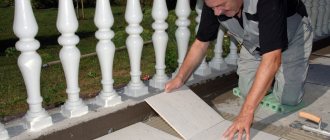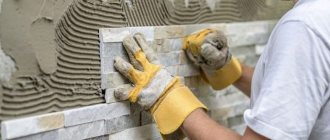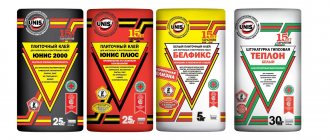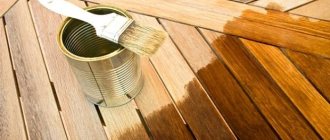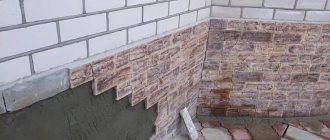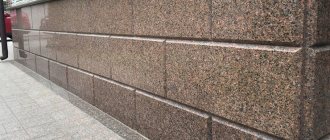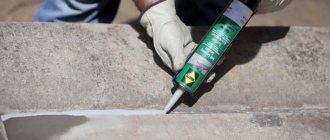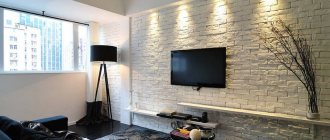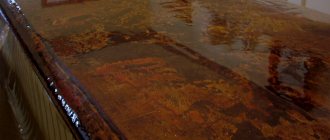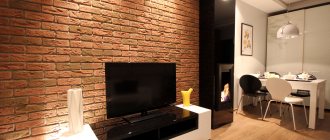The use of natural stone to decorate the facades of buildings for various purposes is a fashionable trend among numerous developers; this option for decorating houses is also recommended by architects. New technology allows you to have modern insulated facade walls in a retro style. In addition, due to its physical properties of strength, natural stone is rightfully considered one of the most durable materials.
Adhesive for natural stone for outdoor use
Façade finishing with natural stone
The finishing of external walls is used in the most unfavorable conditions under constant influence of precipitation, with cyclical changes of positive and negative temperatures. Such conditions require increased attention when choosing an adhesive; it must not only have a high adhesion coefficient with building materials, but also not change its original properties throughout the entire period of operation. Professionals do not recommend using universal compounds; in terms of moisture resistance and frost resistance, they cannot fully satisfy construction requirements. This is especially true for the northern regions of our country, they have the most difficult operating conditions, and not all compounds can withstand them.
It is important to choose the right adhesive composition for stone
When choosing a specific brand, special attention is paid to the country of origin; northern countries, unlike southern ones, take into account the frost resistance factor to the maximum extent and produce adapted adhesives. Currently, domestic companies have mastered the technology for producing high-quality compounds; in many respects they are almost as good as their imported counterparts. Unfortunately, it cannot be said that the cost of domestic products is much lower than imported ones. In the absence of healthy competition, some of them unreasonably inflate the price of their goods.
Glue for stone must be frost-resistant
Characteristics of the adhesive solution
Here are the most important characteristics of natural stone adhesive:
| Photo | Description |
| Application period (solution viability) |
The best option is when the solution can be used effectively for about 120 minutes (2 hours).
During this period, professionals lay stone cladding over the maximum area.
Thanks to this, labor efficiency increases and the cost of cladding decreases.
At its limit, any natural stone adhesive can hold 80 kg/m².
This characteristic makes it possible to use large and thick stone elements for wall cladding.
When the adhesive does not deteriorate from more than 30 freeze/thaw cycles, it means it is frost-resistant.
One point should be taken into account here. For example, the packaging of the mixture indicates its frost resistance of 40 cycles. This means that the glue can withstand so many consecutive freezing and thawing times, and not 40 winters. After all, during the cold season there may be several thaws and cold snaps.
Types of glue for natural stone
Based on the binder used, adhesives for external stone work are divided into two categories:
- Cement mixtures . The basis of these ready-made dry compositions is gray or white Portland cement of grades M-400, 500 or 600. Quartz sand is used as a filler. Various modifiers can be used as additives to improve the characteristics of the adhesive.
Cement adhesive can be used for both interior and exterior work. Its consumption is on average 5 kg per 1 m² of base
- Adhesives based on a polymer binder . They are based on epoxy, acrylic resins or polyurethane. A polyester analogue is used less frequently. All these mixtures are two-component. They consist of a base (container A) and a hardener (container B). Their contents are mixed before applying the glue directly.
Adhesives based on polymer binders have better performance qualities than their cement counterparts. However, they also cost more.
One of the most important advantages of such compositions is elasticity.:
- Thanks to it, the adhesive layer neutralizes changes in the linear dimensions of natural stone during its thermal expansion.
- The strength of the coating increases due to the fact that cracks do not form on the adhesive layer.
- Due to the elasticity of the retainer, the façade coating is not destroyed.
Epoxy based glue is very expensive. As a result, it is usually used only as a frost-resistant grout for granite, marble and other types of stone or when repairing coatings.
Selection of masonry mortar
Here's what you should pay attention to when purchasing adhesive for a stone facade:
- Adhesion level . It determines the reliability of the adhesion between the base and the cladding. Physically, adhesion means mechanical force sufficient to lift the finish from the walls. To install large and heavy stone elements, the tile adhesive must have very high adhesion - at least 1 MPa.
The composition must have a sufficient level of adhesion for laying heavy elements.
- Thermal conductivity of finishing and base . This cladding parameter should be significantly smaller. Otherwise, the home will begin to experience significant heat loss.
The adhesive layer should not be destroyed due to low temperatures.
- Resistance of the mixture to atmospheric influences . In any case, adhesive for facade stone tiles must retain its original qualities when exposed to water and subzero temperatures.
If the material has good thixotropy, the stone can be laid from top to bottom.
- Thixotropy level . This quality determines the ability of the glue to retain its original configuration. In practice, this means that the adhesive composition can hold the finish on inclined and vertical bases without slipping off them.
Recommended values for glue
We will focus only on the most important criteria and accept the average option in terms of quality and price. Make a specific decision yourself, taking into account the characteristics and measurements of natural stone, the location of its installation, the material used to make the façade walls and the climatic zone of your residence.
- Time of use. The best option is that the glue is suitable for use for about three hours. During this time, it is possible to lay stone over a relatively large area - labor productivity increases and the estimated cost of finishing work decreases.
The time for using the finished solution is limited
- The maximum weight held per square meter of stone is 70–80 kg. This indicator makes it possible to use rather large and thick natural stones for finishing facades. The recommended weight of stones depends on the adhesion and strength of the adhesive.
- Frost resistance. If the glue can withstand less than 35 freeze/thaw cycles, then it is not worth purchasing. The fact is that 35 cycles does not mean 35 years; during one winter or year, the temperature can change several times from positive to negative and vice versa.
Choose glue with frost resistance of at least 35 cycles
Carefully read the manufacturer's instructions, choose products only from companies that have been tested by numerous consumers. Never buy counterfeit products, do not be seduced by the low price. The cost of inevitable repair work on facades is several orders of magnitude higher than the amount of savings.
Prices for construction adhesive Ceresit
Ceresit glue
What is natural stone glued to?
Natural stone is laid using either cement mortar or tile adhesive. The second, of course, is better and preferable.
When working with cement mortar, various additives are added to it to improve its plasticity, frost resistance and other properties. Now you can find enough information about this, especially since many people on the Internet share their experience in facing and paving with natural stone.
When purchasing tile adhesive, the choice should be made in favor of well-known brands on the international market. You need to buy from a reliable and trusted supplier: today there are many fakes on the market.
Good adhesives for natural stone are “Litokol”, “Ceresit”, “Knauf”, “Bergauf”, “Basf”. “Unis” and “Plitonit” are often used due to their prevalence and optimal price/quality ratio; “Plitonit” is suitable for external cladding; we do not recommend “Yunis” for this purpose.
Features of installation of porcelain stoneware
The presence of excellent characteristics does not make porcelain tiles eternal. And here a lot depends on the correct installation and accompanying materials, as well as the quality of fastening the product.
When laying porcelain stoneware, the first step is to prepare the base. The area must be clean, free of debris and with devices that will ensure moisture removal. For better mating and long-term operation, experts recommend preparing a concrete screed, for which you need to use high-quality cement, as well as reinforcement and a primer on an already established surface.
It is important to correctly select the adhesive composition that will be used to attach the tiles for the street. Choose an adhesive that says “for porcelain tiles”
You should focus on a product intended for outdoor use that can withstand temperature changes, various humidity conditions and heavy loads. Manufacturers stipulate that the special composition for porcelain tiles can withstand low temperatures down to -150 degrees.
When choosing an adhesive, you need to focus not only on decreasing the temperature, but also on increasing it. Therefore, you should select a composition that can withstand a wide range of changes, for example, from -80°C to +80°C. In addition, the glue must have:
- special additives to increase adhesive ability;
- adhesion strength to the surface ranging from 0.6 MPa to 1 MPa, depending on the weight of one porcelain stoneware tile;
- resistance to significant temperature drops, which is designated by the letter F and has values from 15 to 100, the ideal option is F50.
Do not forget about the ratio of the amount of glue to the area for installation and the thickness of the tile. To make accurate calculations, it is better to contact a specialist, especially if the selected outdoor porcelain tile is in front of his eyes. For those who are accustomed to relying on their own strength, you can take approximate calculations as a basis, where with a layer of glue of 2-5 mm, the approximate consumption per 1 m2 will be 2-5 kg of solution.
Next on the list of materials for laying outdoor porcelain tiles is a grouting compound or mixture. Using grout, you can refine the joints between installation fragments, although it performs not only a decorative function. The presence of a high-quality grout prevents moisture from getting between the tiles.
Only the grout should be chosen according to the classification equal to the adhesive composition and finishing porcelain stoneware. If the material is frost-resistant, then the mixture should have corresponding properties. Otherwise, the entire installation procedure may go down the drain due to stupid savings on the quality of grout.
Adhesive mixtures "Litokol"
"Litokol" is an excellent manufacturer. Their adhesive mixtures are indeed of high quality. The downside is the high price. But if you still buy this brand of glue, you won’t have to regret your choice. For natural stone, the manufacturer offers the “Litoflex K80” series. This is not the only option; the manufacturer offers several adhesive mixtures for natural stone. Do not skimp on spending your time familiarizing yourself with the line of cement adhesives on the website www.litokol.ru.
The best moisture-resistant tile adhesive
This is a special adhesive for installing tiles in bathrooms and on steps. It contains a hydrophobic modifier, which allows you to line even fountains and swimming pools.
Litokol Litoelastic
5.0
★★★★★ editorial assessment
100% of buyers recommend this product
See review
This is a reactive epoxy-polyurethane adhesive that does not require water to prepare. You just need to mix its two components.
The product is used for external and internal cladding of vertical and horizontal surfaces with natural stone and ceramic tiles.
Advantages:
- High adhesion;
- Frost resistance;
- Not susceptible to cracking;
- No shrinkage when drying;
- Resistance to deformation.
Flaws:
High price - from 3000 rubles per 4 kg bucket.
Litokol Litoelastic will even glue mosaics and tiles to a metal base. The glue is super reliable and versatile in its own way, but very expensive.
Knauf Flex
4.9
★★★★★ editorial assessment
96% of buyers recommend this product
This adhesive is intended for areas of high loads, as well as for lining pool bowls. The solution remains viable for 3 hours. The open operating time is 20 minutes, there are 10 minutes for adjusting the tiles.
Advantages:
- Resistance to severe dynamic loads;
- Compatible with substrates that do not absorb water;
- Water-, frost-, heat-resistant;
- Maintains elasticity after hardening;
- Does not generate dust during operation;
- The widest operating temperature range (-50..+80 °C).
Flaws:
Increased consumption.
This adhesive is used for vertical and horizontal surfaces without restrictions on the size and weight of the tiles to be laid.
Weber.Vetonit Easy Fix
4.8
★★★★★ editorial assessment
89% of buyers recommend this product
This glue has a cement base, which gives a gray color. You can work with the prepared solution for about two hours at a temperature of +5..+35 degrees. For 1 sq. m. it takes about 3 kg of dry product.
The time for open use and correction of tiles is no more than 15 minutes. The composition is waterproof, but it cannot be used for heated floors and other high-temperature surfaces.
Advantages:
- Adhesion more than 1 MPa;
- Suitable for outdoor use;
- Frost resistance;
- No tile slipping;
- Reliable fastening.
Flaws:
Cannot be used with primers containing quartz sand.
This adhesive can be used for laying mosaics, as well as for indoor and outdoor tile installation.
Unis "Pool Hydro"
4.8
★★★★★ editorial assessment
87% of buyers recommend this product
The composition is designed for laying tiles no larger than 60x60 cm in water tanks. It is also suitable for natural stone and mosaic. With it you can lay tiles using the top-down method.
The glue is frost-resistant and after drying can be used at temperatures from -50 to +70 °C.
The solution can be worked at temperatures from +5 to +30 °C, and its pot life is 180 minutes.
Advantages:
- Used both indoors and outdoors;
- Suitable for heated floors;
- The time for laying and adjusting tiles is 20 minutes;
- Strong adhesion (1.3 MPa);
- Can be used on difficult substrates.
Flaws:
Operation in contact with water and negative temperatures is possible only after 28 days.
This is a multifunctional composition used for areas with difficult operating conditions. However, it must be given enough time to gain strength.
Prospectors "Lux"
4.7
★★★★★ editorial assessment
84% of buyers recommend this product
See review
The adhesive is intended for ceramic and clinker tiles, porcelain stoneware, as well as artificial and natural stone. It is used in unheated and damp rooms, as well as outdoors.
Suitable for laying tiles in water tanks. No more than 15 minutes are allotted for adjustment, and the open time is 20 minutes.
Advantages:
- Suitable for heated floors (heat resistance up to +70 °C);
- Can be laid on old tile flooring;
- The viability of the solution is at least 4 hours;
- Frost resistance;
- Plasticity of solution.
Flaws:
The format of the tiles used should not exceed 40x40 cm.
This product is easy to work with - it does not slip and is easy to apply. However, exceeding the recommended layer of 3-5 mm can lead to shrinkage of the tiles.
Adhesive mixtures "Quick-mix"
Let us note another manufacturer that has received international recognition - “Quick-mix”. It produces adhesive mixtures and solutions for a wide variety of masonry and finishing materials, and most importantly, you can always choose an option for specific cladding conditions. Adhesive mixtures of this brand are less common compared to the above. But if you are lucky enough to meet them, feel free to buy them. The price is high, but the glue is worth it.
By the way, “Quick-mix” produces route mortars and systems with tubag filler for paving natural stone and paving stones. Stone paving with these systems becomes technologically correct and is greatly simplified. The company website is www.quickmix.ru.
Of the adhesive mixtures, we recommend Quick-mix FX-300 for light stones, Quick-mix FX-600 as the main glue. For hard stone - “Quick-mix FX-900”.
Here we have listed the adhesive mixtures that masons most often work with. Therefore, do not skimp on spending your time and reading about other brands on construction forums. There are many good adhesives today.
By the way, please note: for gluing certain types of stone, you can use liquid nails (for example, in our case it is travertine tiles), epoxy-based adhesives, and mastics.
VERY IMPORTANT: when facing light-colored marble, you must use only white glue! Marble is a highly absorbent material. Some time after laying on gray glue or ordinary cement mortar, gray-yellow spots may appear on its surface. And nothing can remove them. You can buy “Ceresit CM 115”, “Lotokol Lotoplus K55”, “Plitonit S marble”.
Properly selected adhesive is the key to high-quality cladding work. The choice of adhesive for stone determines both the strength and durability of the work performed, be it cladding a façade with natural stone or finishing the interior with artificial material. It is important to understand that each case requires special glue. In this article you will learn about the technical characteristics, proper application, as well as the main indicators of a good adhesive composition.
Frequently asked questions about gluing stone
Can stone be glued to drywall?
If necessary, natural stone can be glued to drywall, but taking into account the following aspects:
- Use stones that are as light in weight as possible;
- Drywall must be moisture resistant and very carefully treated with a primer.
It is also worth considering that the work done will not last too long.
Is it possible to glue natural stone to wallpaper?
You cannot glue the stone to the wallpaper, as the glue will soak the paper and the stone will simply fall off.
Is it possible to glue stone to stone?
Yes, you can glue stones together, but to do this you should use a special glue with quick-drying polyester components.
The role of glue in facing work
Cladding facades with stone allows you not only to give the building an attractive appearance, but also to insulate the walls. In addition, stone is one of the strongest materials. It is important to choose not only a durable material, but also a suitable adhesive for it. The facade will have to withstand adverse weather conditions, exposure to sunlight and precipitation, so the adhesive must ensure the durability of the cladding.
The same applies to interior work. The stone can be used both for cladding ordinary premises and places constantly exposed to water. Stone tiles have proven themselves in swimming pools, showers, and artificial ponds. Therefore, stone adhesive must take into account the increased humidity of the room.
What type of tiles is street adhesive intended for?
The result of choosing the wrong tile
For anyone. Since the frost-resistant adhesive is “reinforced”, it is able to withstand all types of tiles - from ordinary tiles to heavy porcelain tiles.
But not all types of tiles will withstand street conditions... This is just the question of the destruction of tiles.
You can often come across a picture of cracked or fallen tiles, the base or parts of which continue to “show off” on the installation surface, unpleasantly spoiling the overall appearance of the building.
This happens due to the incorrectly chosen type of tile - porous “light” ceramic ones are not at all suitable for outdoor conditions. Even a good frost-resistant glue will not “keep” them from destruction, since due to temperature changes, water will first penetrate into the holes (pores) of the tile and then freeze there, gradually destroying the tile.
Therefore, for outdoor work it is so important to choose the right not only glue, but also frost-resistant tiles. But its size and weight are not of fundamental importance - the reinforced street adhesive can withstand even the heaviest porcelain stoneware slabs
But its size and weight are not of fundamental importance - the reinforced street adhesive can withstand even the heaviest porcelain stoneware slabs.
Which is better
Stone adhesive is selected according to the type of cladding and type of stone tile.
The material is divided into two groups:
- Natural stone, or natural - dolomite, granite, marble, sandstone, etc., formed under natural conditions. It is cut into decorative sheets of different thicknesses, lengths and shapes.
- Fake diamond. This group, in turn, is divided into stone created from polymer resins, and stone made by sintering or based on cements (this type is close to natural).
Briefly about the main thing
Artificial stone is made from various materials, which affects its technical characteristics. The area of application of the cladding and the choice of glue depend on them.
Decorative stone is laid on a prepared base. Next, the seams are filled and a protective coating is applied.
The choice of adhesive is based on operating conditions: temperature, humidity, level of mechanical load, base material.
The quality of the finished result depends on the elasticity of the adhesive composition, the permissible layer, adhesion, strength, speed of setting and hardening.
Seamless masonry is carried out using ready-made mortars with white pigment or colorless.
Reactive compounds are used for ceilings and inclined surfaces.
The heavy stone is laid on reinforced glue.
Ratings 0
Specifications
Depending on the main component, adhesives are divided into two groups:
- Cement based stone adhesive. For production, gray or white cement M400-M600 is used. The most budget models belong to this group. Cement is used to make glue for both natural and artificial stone. It provides a strong connection between the tile and the surface. The composition is resistant to chemicals and withstands bad weather conditions. This glue hardens within 6 hours, which makes it possible to easily correct defects. Glue for quick masonry is also available, which dries in 1.5 hours.
- The base is epoxy resin and polyurethane. Adhesive for natural stone based on these substances compensates for changes in the linear dimensions of the stone and surface due to thermal expansion, and all thanks to plasticity. Adhesive for artificial stone based on acrylic compounds is high-strength, resistant to temperature changes. Such compositions cost much more than cement ones and require special care during preparation and use. An advantageous difference from the first group is that this glue does not crack and blocks the proliferation of moss and lichen. However, due to the high cost of the product, it is often used only for grouting joints or for repairing individual fallen-off cladding parts.
Classification of glue according to special properties
- Heat resistant
- Frost-resistant
- Fast-hardening
- Leveling
- Elastic and highly elastic
- Thick layer
- Universal
- With reinforced fixation
Heat resistant
This solution is used for lining stoves, fireplaces and heated floors.
Must withstand temperatures above 100⁰C. As a rule, long-term heating up to 175⁰C and short-term heating up to 1200⁰C. What makes it possible to lay ceramics on a stove, fireplace or heated floor. In this case, a less heat-resistant solution can be used for lining the chimney. Heat-resistant tile adhesive is indispensable for lining stoves, fireplaces and heated floors.
Frost-resistant
As a rule, it is a dispersion mixture. But frost-resistant tile adhesive must withstand not only low temperatures, but also its sudden changes. Therefore, the manufacturer is required to indicate on the packaging that the glue is frost-resistant. Moreover, there are mixtures that have both frost resistance and heat resistance. Which can be used for lining stoves located in rooms with irregular use.
The properties of frost-resistant adhesive allow it to be used for ideal laying of ceramic tiles.
Fast-hardening
This type of tile adhesive hardens in 3-4 hours. This allows you to quickly start using it. But it is more difficult to work with, since it sets in 5–10 minutes. After which it is no longer possible to install materials. Therefore, it must be placed quickly and accurately.
Quick-drying tile adhesive is a great help for people who want to finish their renovation work quickly.
Leveling
This type of mortar is used when laying tiles on an uneven surface with differences of more than 1cm. Why is it necessary to use cement mixtures? And, naturally, this significantly increases glue consumption. Therefore, such installation will cost more. In view of this, this is rarely justified from the point of view of the cost of the work. But in some cases it is simply necessary.
Leveling adhesive for tiles is a mixture of cement, graded sand and polymers that give it different properties.
Elastic and highly elastic
The elasticity index of a solution determines its ability to sag under mechanical influence. Thus, two classes of elastic adhesives are distinguished: S1 and S2. S1 assumes the possibility of deflection of at least 2.5 mm. S2 - allows the mixture to sag by more than 4.9 mm. Accordingly, S1 is an elastic tile adhesive, and S2 is highly elastic.
Elastic adhesive compositions for laying tiles contain modified additives and plasticizers.
Thick layer
The layer thickness indicator refers to cement-based mixtures. Since these solutions are used to correct coating unevenness. Thus, for coating defects of no more than 10 mm, a thin-layer solution is used. When the solution is used not only as a mixture for tiles, but also as a leveler, then a thick-layer mixture is used.
Thick-layer tile adhesive is used for laying large-format floor slabs made of ceramics, porcelain stoneware or artificial stone.
Universal
This type of tile adhesive is suitable for both exterior and interior use. But it should be borne in mind that it may not be very reliable when using ceramics larger than 30X30 cm, as well as when there are temperature changes and high humidity. Therefore, it is better not to put it in the bathroom. And besides, it is not recommended to use it for cladding rooms located in difficult climatic conditions.
For some tile models, universal adhesive may also be suitable. This applies to models 10x10, 20x20, 30x30 cm.
Reinforced adhesive
Mixtures of enhanced fixation include dispersion, polyurethane and epoxy solutions. As a rule, they are used when covering walls with large materials. Since such a solution has increased adhesion properties.
The key feature of reinforced fixation tile adhesive is its increased resistance to static and dynamic loads.
Manufacturers
The market provides a large selection of adhesives for different purposes. Here are the best of them in terms of price-quality ratio:
- “Keralastik T” is a two-component composition, suitable for exterior finishing. Holds masonry even on deformed surfaces.
- Keraflex is a cement-based dry mix. Tolerates adverse weather conditions and exposure to chemicals well.
- "Yunis" is an easy-to-use dry mixture with good performance for indoor cladding.
- Plitonit is an inexpensive composition, suitable for both internal and external cladding.
- Elastorapid is a mixture of sand and synthetic resins, suitable for finishing vertical surfaces and withstands extreme temperatures.
Several options for using porcelain stoneware outdoors
You can decorate various areas with ceramic tiles. And for the street, porcelain tiles, and even well-chosen ones, have a wider range of applications, since they are used to decorate garage buildings, summer verandas, and terraces. The most common areas of application:
Entrance area
The anti-slip surface of the tiles with a beautiful wood or stone pattern will add zest to any interior. And the roughness of porcelain stoneware will allow you to eliminate door mats, which will make the entrance more modern.
steps
For these purposes, ready-made tiles cut to size are used. It has special non-slip stripes applied to it, and the cut end is given an attractive appearance instead of a line.
Paths
Frost-resistant porcelain tiles are best suited for laying paths. Only during installation should you carefully follow the technology and all recommendations for the use of special adhesive and grout solutions. When forming a path, you can show all the possibilities of your own imagination, deviating from the standard form and designing the area in an original style.
Terraces and verandas
Open terraces and verandas, which in modern houses are a kind of transition between the street and the house. Such rooms are decorated more in street style and materials are selected accordingly. Laminate and linoleum will not last long, but porcelain floor tiles are just right. It is recommended to select the same types as when entering the house. Only experts advise using adjustable supports during installation.
Garage and bathhouse
Considering the long service life, you can use porcelain stoneware for the floor in the bathhouse and garage. The peculiarities of using these premises are that they are characterized by temperature changes and various man-made impacts. In the bathhouse there is boiling water, steam, after which a cold regime often sets in for several days. And in the garage there is a lot of lubricants and other substances that have a destructive effect. The properties of porcelain stoneware will allow you to maintain the integrity of the surface and decent appearance for a long time.
Application
Cement compositions are used mainly for external masonry. Cement-based glue is very easy to prepare. Simply pour the prepared mixture into a bucket, add latex compound or water, and mix everything with a mixer. If the composition for artificial stone has hardened, it should not be re-diluted with water. Stone tiles will no longer stick to such glue. Therefore, the adhesive must be used within 6 hours after its preparation. For express glue, the “shelf life” is 1.5 hours.
Artificial compounds are used for indoor masonry. Working with glue for artificial stone is a little more complicated. Sold in packages with cartridges with filler and hardener. They are squeezed out using a gun and mixed in a ratio of 10:1. This glue is applied to any surface and allows you to make ceiling cladding. Work with the finished composition should be carried out within 15-30 minutes, depending on the temperature: the higher it is, the faster polymerization occurs.
Always follow the instructions on the package, and you won’t have any problems working with any glue!
| Brand 2. Knauf |
| Brand 3. Unis |
| Brand 4. Plitonit |
| Brand 5. Litokol |
| Brand 6. Quick-mix |
| Brand 7. Mapei |
Tips for using stone glue
Experienced craftsmen give several useful recommendations when purchasing and using glue for natural stone for outdoor work:
- It is not recommended to buy glue whose shelf life is less than 6 months.
- The glue must be stored in a covered and better heated room, so it is also not recommended to buy it at the market.
- An open pack of glue can be stored in a dry place for half a year.
- The dry glue mixture must be poured into a container of water, but in no case vice versa.
- It is more convenient and practical to stir the mixture with an electric mixer, in 2 stages, so that lumps do not form.
- If the glue has hardened a little, you need to mix it well and not dilute it further with water.
- Before gluing the stone, the surface must be treated with a primer.
- It is best to apply the glue with a serrated spatula.
Consistency
These products are available in various configurations, which differ in cost and basic properties.
Liquid
It is a paste-like mixture, which after opening the package can be immediately used for its intended purpose. Master minute of confrontation is enhanced by mixing the components according to the composition. The disadvantage of this type of product is its high cost.
Liquid
Dry
Can only be used after special training. It must be diluted with water in the proportion indicated in the instructions.
Dry
Provides reliable fastening, can be used on uneven surfaces, and also provides the ability to dismantle.
For more information about tile adhesive, watch the video:
How to use it correctly
To achieve success in using the material, you should do the following:
- Mix stone tiles from different packages and lay out the pattern on a flat surface. Only after this is it permissible to begin installation. Thanks to the preparatory work, it is possible to simplify the choice of shades and sizes of tiles, as well as speed up the process of fixing them.
- From the surface of the coating it is necessary to remove all remnants of dyes, dirt, oils, glue and cover with a primer layer. If necessary, the coating should be moistened.
- If the stones are heavy, a reinforcing metal mesh is installed.
- After this, it is permissible to begin preparing the adhesive composition. The result should be a strong and elastic seam. It is recommended to dissolve the composition in water. The result should be a thick mass. It retains its characteristics for 3 hours.
- It is recommended to apply the substance to the surface with a notched trowel. The same tool should be used to level the composition.
- The tiles should be covered with glue using a flat spatula. Its thickness should not exceed 1 centimeter.
- Then it is recommended to make sides out of glue, and to press the stones into the wall using rotational movements. As a result, excess substance will come to the surface. This technique helps seal the seam. It is recommended to remove excess glue.
- If masonry is carried out in rooms with high humidity parameters, it is worth using a hydrophobic solution. This substance reduces the level of moisture absorption and provides protection against salts and lime deposits.
Basic requirements for the adhesive composition
In order for the adhesive to provide reliable and long-lasting fixation, it is important to choose it correctly. The composition must meet certain requirements.
High adhesion
The key selection criterion is adhesion. This term refers to the strength of adhesion of the finish to the base. Adhesion is measured by the force required to separate the adhesive material from the wall. For difficult bases and fastening of large materials, this figure should be at least 1 Megapascal.
Strength
High-quality glue should withstand 80 kilograms per 1 square meter. This parameter makes it possible to use the substance for cladding walls with large or thick stones.
See also
How to repair a muffler using high-temperature sealant, description and composition
Moisture resistance
The substance should not change its characteristics under the influence of moisture. This will ensure reliable fastening in all weather conditions.
Frost resistance
The adhesive must withstand a minimum of 35 freeze/thaw cycles. This does not mean that the mount will last 35 years. Several temperature fluctuations can be observed in one season.
Advantages of artificial stone made of concrete and cement
Recently, cement has been actively used for the manufacture of decorative stone and brick. Using this material, it becomes possible to veneer almost any surface with significant advantages over natural stone:
- concrete stone weighs much less than natural stone;
- using a pouring mold you can get all the stones of the same thickness, which will greatly facilitate installation;
- there are endless variations in the design of artificial stone, a variety of shapes and patterns;
- its pricing policy is publicly available and allows for significant savings;
- Concrete tiles have a fairly long service life and can last from 20-25 years.
The variety of tiles that can be obtained using only concrete mixed with certain components is truly surprising. This is an imitation of marble, granite, and labradorite, as well as almost any stone that is used for facing work. If all the manufacturing nuances are observed, even an experienced eye will have a hard time distinguishing a natural stone from a decorative one.
The photo shows a facade made of decorative (artificial) stone made of cement
Cement has good sound insulation. Therefore, by covering the walls of your home with even a thin layer of concrete tiles, you will protect yourself from unnecessary street noise and screams. Cement tiles are not recommended to be laid indoors, since although they are lighter than natural stone, they are still much heavier than gypsum tiles. In addition, cement is superior to gypsum in price and shelf life. So, if your home does not have very wet rooms, then it is more advisable to make plaster cladding. In the previous article, we told you how to independently make decorative (artificial) stone from gypsum for interior decoration.
But for external cladding work, concrete decorative tiles are perfect. Modern craftsmen think through the design to the smallest detail and use up to several types of different slabs in the cladding of one object. Thus, the basement of the building is laid out with imitation boulders, the middle line with slate rocks, and the top of the building with artificial bricks. Of course, it is not necessary to experiment with many forms at once - a facade lined with solid decorative brick of one type is in no way inferior in its effectiveness and beauty.
Now it is very fashionable to use concrete tiles in the street decoration of cafes, restaurants, parks, as well as shops and office premises. It looks prestigious, fashionable and modern.
Features of choice for various surfaces
To achieve reliable fixation of finishing materials, it is necessary to select the correct adhesive composition, taking into account the type of stone.
Granite
This is one of the heaviest types of stones that are used for outdoor work. It is characterized by high cost. Granite often crumbles when cutting. To attach the material to vertical surfaces, two-component adhesives are used. They must have high adhesion rates. For horizontal coatings, a cement adhesive composition is suitable.
Marble
This material is characterized by different shades and patterns. At the same time, marble is considered less durable than granite. To attach the material, two-component adhesives or cement-based substances are used. They must contain innovative components.
Sandstone
This material is characterized by average parameters. It is actively used for finishing facades. This option is considered very budget-friendly. Available cement-based mixtures are suitable for fastening sandstone.
Quartz slate
This is a common material that can be used for facades or decorative finishing. To fix wild shale, it is permissible to use cement compounds of average price. This stone is characterized by excellent technological characteristics. Therefore, there is no need to use expensive substances.
Limestone
This stone is characterized by low density and low mass. The downside of the material is that it crumbles easily. The coating also absorbs a lot of moisture. Limestone should be fixed using dry compounds, which are characterized by high strength and adhesion.
How to glue decorative stone - instructions
Before work, you need to buy the required amount of decorative stone. It will be equal to the area of the walls that are supposed to be finished. When purchasing, it is important to consider the purpose of the material (for interior or exterior use), moisture resistance, if you have to stick it in wet rooms. For the hall, bedroom, hallway, gypsum stone is usually chosen, for the bath, kitchen - acrylic or cement. Products must be inspected to exclude the presence of cracks, chips, and certificates must be requested.
To determine exactly how much stone you will need, it is advisable to first draw up a sketch of the wall decor. The type of installation will also depend on the shape of the stone - rectangular products are laid in offset rows, like a brick. Wrong elements will have to be first laid on the floor, matching each other, and only then glued to the wall. You should do the same if you want to put a drawing on the wall (for example, in different colors).
Load calculation
The force of the load will depend on the type of coating, as well as a number of other parameters. To calculate, you need to know the following indicators:
- S total – wall area;
- S tiles – area of one tile.
By dividing these numbers, you can get the required number of tiles that will be laid on the wall. You also need to think about how the masonry will be done - tightly or with seams, and clarify the thickness of the seam. By subtracting the area of the joints from the original one and then dividing by S tiles, the rate of stone consumption will be more accurate. The load on the wall can be calculated by multiplying the weight of one element by their number.
Materials and tools
To lay artificial stone, you should prepare everything you need in advance so as not to be distracted while working. Depending on the installation method and type of glue you will need:
- level, pencil and tape measure;
- spatulas - simple, with teeth;
- square;
- trowel or trowel;
- rubber mallet;
- drill or construction mixer;
- glue gun;
- hacksaw and miter box;
- cross-stitching;
- foam sponge;
- paint brush;
- container for diluting glue;
- wooden block;
- metal brush;
- Bulgarian.
You also need to buy the actual stone and glue, a jointing mixture to match the color of the artificial decor or a contrasting shade, a primer for the walls, and acrylic varnish for final processing.
Surface and stone preparation
The ideal option is to glue the material to walls that have not previously been finished. In this case, you can simply remove minor defects and prime the base using acrylic or polyurethane primer. When there is paint or wallpaper on the walls, they will have to be removed. To do this, you can use a metal brush or a sharp spatula, after spraying the base with water.
Surface preparation may also include the following:
- applying plaster or putty;
- thorough priming of the base to remove dust and enhance adhesion;
- priming all elements from the inside (it is better to treat gypsum tiles twice);
- marking the wall for easy gluing of finishing elements.
It is recommended to first cover very uneven walls with plasterboard or OSB board. In this case, the stone should be installed using elastic acrylic glue, otherwise the masonry will crack in the future. Drywall, like smooth wooden bases, does not need to be puttied, but only if the stone is laid without seams.
Decorative stone also needs to be prepared:
- cut the elements into pieces of the desired shape, size with a hacksaw or grinder;
- be sure to trim the outer tiles in the masonry one at a time (for gypsum stone it is better not to use a grinder, it contributes to the splitting of the slabs);
- clean the cut areas with a file to give a natural look; you can also use this tool to make torn edges of the tiles;
- The attractiveness of the masonry will be given by sawing off the corners of individual elements;
- if necessary, apply acrylic paint (usually this is done when purchasing white material).
Rules and principles of installation
If the tiles have been purchased and prepared, the glue has also been purchased, you can start working. The principle of wall finishing is the same regardless of the method (with or without seams), the only difference is in the details.
The procedure will be as follows:
- Mixing glue. Dry building mixtures are added to a strictly measured amount of water, but not vice versa. Then the mass is mixed with a mixer, a drill with an attachment, and as a result the glue should be thick, elastic, and homogeneous. Ready-made formulations are used immediately.
- Gluing tiles. The glue is applied to the wall with a spatula, ensuring the uniformity of the layer. You cannot cover the entire wall at once. It is enough to do this only on 1 square meter, otherwise the product will dry out and lose adhesion to the tiles. If ready-made glue or sealant is used, it is applied to the elements themselves in waves. Artificial stone must be pressed tightly against the wall, especially when laying on cement mortar, but the glue should not be allowed to come out too much. It is necessary that it comes out in a small amount, then the voids will be filled and completely sealed. Tips for laying tiles:
- start finishing from the bottom row when using the seamless method, from any angle - when using the seam technique;
- if stones of different sizes or colors are used, the asymmetry of the shapes will look beautiful; if the details are the same, you should create only clear, correct designs;
- It is recommended to glue the cut edges to places that are hardly noticeable to the eye, so that the wall looks more aesthetically pleasing;
- installation is carried out row by row from bottom to top; you can also start installation from the middle of the wall, having previously attached a guide rail (wooden block, metal profile);
- giving the desired position to the tiles is best done with a rubber hammer.
- Creating seams. To form seams, gaps of up to 2-12 mm are left between the elements. They must be made uniform, and the rows run parallel to each other. Some carelessness in styling is acceptable; it will be practically unnoticeable. With the seamless technique, the elements are glued tightly to each other. If glue gets on the front side of the material, it must be removed immediately, otherwise it will be difficult to clean the tile later.
- Cleaning seams. The glue that has filled the seams must be removed as much as possible, because in its place there will be a special grout. Only jointing and glue of the same composition require leaving the latter in the seams. After the glue has hardened, the seams can be painted in any tone to highlight the beauty of the stone.
- Grout. To form beautiful seams, you need to dilute the grout according to the instructions on the package, then put the portion in a small bag. It will be convenient to squeeze the mass out onto the seams. A construction gun is perfect, you can even use a regular pastry syringe, however, it is not advisable to use it for food purposes. The squeezed-out product must be carefully leveled with a narrow spatula. After the mixture has dried, clean the surface of the tiles with a dry soft brush to remove grout residue. The final drying time for the glue and grout is 3 days.
Features of arranging seams and corners
Laying decorative stone is usually considered an easier task than installing tiles. As a rule, problems arise only with the formation of corners and seams. Beginners often overlap corners, but this option will only look normal if the side walls are smooth. Elements cut at 45 degrees in the corner look more beautiful, and minor flaws can be covered with putty.
How to properly make seams between stone parts? Working with crosses is more reliable, but rather time-consuming. It’s easier to work without crosses at all, but you’ll have to mark the wall in advance. Smoothly drawn lines will allow you to lay neat rows, and the seams will be the same. It is better to apply the glue in a layer of up to 3 mm, then the seams will require less processing.
Application of a protective composition
The last stage of creating a decorative stone coating is treating it with protective acrylic compounds. This clause must be observed in the following cases:
- the tiles are made on the basis of gypsum;
- the room has high humidity;
- there is a risk of regular damage to the finish (for example, animals live in the house).
Coating with special means extends the life of the decor, creates a waterproofing film, and also allows you to give a new shade to the material. It is advisable to choose a solvent-free, water-based composition - it is more environmentally friendly. Apply varnish only when the jointing is completely dry. For work use a brush, sprayer, roller.
Basic mistakes
If the operating technology is incorrect, the result may be less attractive and of poor quality. It is also possible to increase the cost of material if, when cutting, a large volume of waste or damaged tiles is allowed to appear. As for errors, the most common ones are:
- leaving streaks of glue until it hardens, when it is difficult to remove them without damaging parts;
- sloppy, uneven application of seams;
- formation of seams that are too wide;
- ignoring priming the inside of the tiles and applying protective agents.
It’s better not to make such mistakes, then the work will be of higher quality, the masonry will be beautiful, as if it was done by a real professional.
Types of construction adhesive
In order for a product to be suitable in a particular case, before purchasing you need to familiarize yourself with its composition and study all the characteristics. There are many types of glue available on the domestic market. Let's look at each of them.
Universal
It copes well with tasks such as cladding internal and external surfaces. The universal adhesive is easy to use and can be applied to small, large, and medium slabs. The product is used for cladding buildings from the outside.
It is suitable for clinker-type ceramics, as well as porcelain stoneware. Before choosing an adhesive for construction work, it is necessary to consider the upcoming technological nuances. You should study the recommendations of the manufacturers of this product regarding internal and external cladding. The glue must be of high quality, resistant to moisture, temperature changes and low temperatures.
Reinforced
This type of glue is applied to a surface whose area does not exceed 30 cm. The product has good adhesion, is universal, and is often used for laying tiles on walls. Reinforced adhesive is suitable for interior finishing work; it is best used for cladding a building from the outside.
The product can withstand mechanical loads and is resistant to temperature changes. However, the manufacturer does not recommend using it for laying porcelain tiles.
Moisture resistant
The adhesive is used for lining the outside of swimming pools because it is resistant to water. Moisture-resistant glue is used for outdoor work. It is intended only for artificial mini-reservoirs. But if water constantly affects the adhesive composition, its structure is disrupted, resulting in the finishing material peeling off. For this reason, glue is not used to line the inside of the pool.
Heat resistant
It can be called the complete opposite of the frost-resistant species. The product is used for lining stoves, fireplaces, and other devices exposed to high temperatures. The adhesive is applied to non-standard surfaces; it is also used when it is necessary to lay tiles on wood or a metal surface.
This glue is used for tiling with transparent mosaics. It provides good adhesion to surfaces.
Frost-resistant
It is used in the process of external finishing work. Frost-resistant outdoor tile adhesive is resistant to temperature changes. It contains additives that increase elasticity and improve adhesion to the surface of the facing material. Frost-resistant tile adhesive does not deform and can withstand low temperatures down to -50 degrees.
Suitable composition option
As for the brand and type of mixture for stone laying, they are indicated in the building designs. The compositions are developed in special conditions of construction laboratories. In this case, the proportions of the mortar for laying stone must be maintained in the strictest order. And this can be done at factory facilities, with special mixers and dispensers.
The mixture can also be prepared directly on the site of the facility. But it will be much more difficult to do this exactly.
- Where to sell cast iron for scrap in Moscow at a good price?
- Comprehensive development of web site design
- Advantages of timber houses
The simplest option to prepare a solution is to use a special dry mixture. For its final preparation, you will need to add water and then mix thoroughly. Today, there is no point in bothering with questions about how to make a mortar for stone laying, since modern manufacturers produce a variety of materials, and also take into account the base material.
Stone in the interior
The decorative material fits so harmoniously into modern apartments and is combined with other building materials that ideas for its use have become available to everyone. When planning a renovation, a person looks at examples of room design for inspiration, so that he can then implement the designs he likes in his apartment.
Having studied catalogs with renovations of modern apartments, we can highlight popular places for decorating with stone materials:
- columns, bar counters, arches;
- fireplaces;
- decorative stone in the corridor;
- kitchen apron;
- slopes, corner elements;
- balconies, loggias;
- baths and swimming pools;
- facades of houses.
